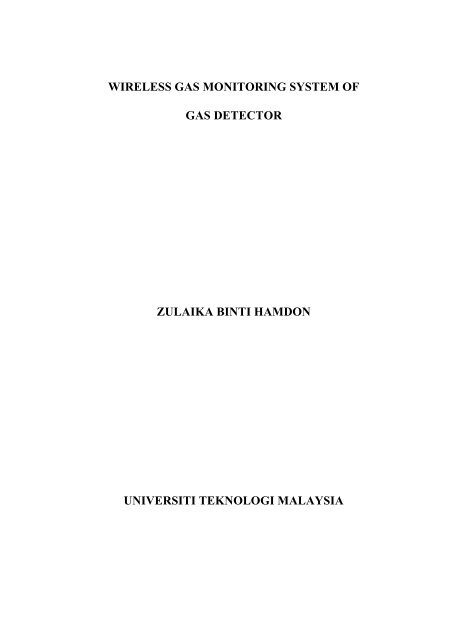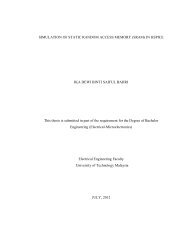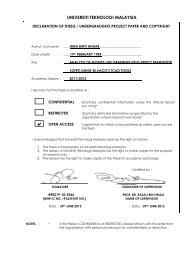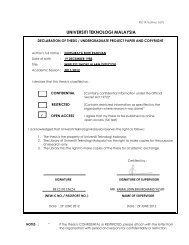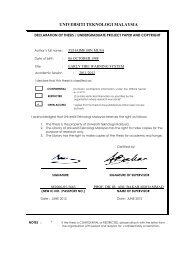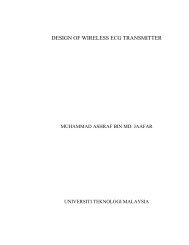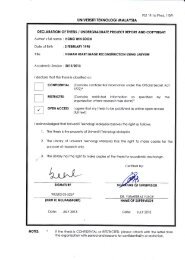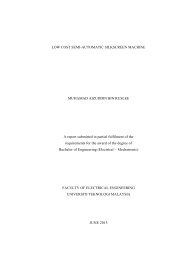wireless monitoring system of gas detector - Faculty of Electrical ...
wireless monitoring system of gas detector - Faculty of Electrical ...
wireless monitoring system of gas detector - Faculty of Electrical ...
Create successful ePaper yourself
Turn your PDF publications into a flip-book with our unique Google optimized e-Paper software.
WIRELESS GAS MONITORING SYSTEM OF<br />
GAS DETECTOR<br />
ZULAIKA BINTI HAMDON<br />
UNIVERSITI TEKNOLOGI MALAYSIA
PSZ 19:16 (Pind. 1/07)<br />
UNIVERSITI TEKNOLOGI MALAYSIA<br />
DECLARATION OF THESIS / UNDERGRADUATE PROJECT PAPER AND COPYRIGHT<br />
Author’s full name :<br />
ZULAIKA BINTI HAMDON<br />
Date <strong>of</strong> birth : 20 JULAI 1989<br />
Title : WIRELESS GAS MONITORING SYSTEM OF GAS DETECTOR<br />
Academic Session: 2010/2011<br />
I declare that this thesis is classified as:<br />
CONFIDENTIAL<br />
RESTRICTED<br />
OPEN ACCESS<br />
(Contains confidential information under the<br />
Official Secret Act 1972)*<br />
(Contains restricted information as specified by<br />
the organization where research was done)*<br />
I agree that my thesis to be published as online<br />
open access (full text)<br />
I acknowledged that Universiti Teknologi Malaysia reserves the right as follows:<br />
1. The thesis is the property <strong>of</strong> Universiti Teknologi Malaysia.<br />
2. The Library <strong>of</strong> Universiti Teknologi Malaysia has the right to make copies for the<br />
purpose <strong>of</strong> research only.<br />
3. The Library has the right to make copies <strong>of</strong> the thesis for academic exchange.<br />
Certified by:<br />
SIGNATURE<br />
SIGNATURE OF SUPERVISOR<br />
890720-06-5310 MRS. NORHAFIZAH RAMLI<br />
(NEW IC NO. /PASSPORT NO.)<br />
NAME OF SUPERVISOR<br />
Date: 6 th JULY 2012 Date: 6 th JULY 2012<br />
NOTES :*If the thesis is CONFIDENTAL or RESTRICTED, please attach with the letter from<br />
the organization with period and reasons for confidentiality or restriction
“I hereby declare that I have read this thesis and in my<br />
opinion this thesis is sufficient in terms <strong>of</strong> scope and quality for the<br />
award <strong>of</strong> the degree <strong>of</strong> Bachelor <strong>of</strong> Engineering (<strong>Electrical</strong> – Medical Electronics)”<br />
Signature : ………………………………………...<br />
Name<br />
: MRS. NORHAFIZAH BINTI RAMLI<br />
Date : 6 th JULY 2012
i<br />
WIRELESS GAS MONITORING SYSTEM OF<br />
GAS DETECTOR<br />
ZULAIKA BINTI HAMDON<br />
A report submitted in partial fulfillment<br />
<strong>of</strong> the requirements for the award <strong>of</strong> the degree <strong>of</strong><br />
Bachelor <strong>of</strong> Engineering (<strong>Electrical</strong> – Medical Electronics)<br />
<strong>Faculty</strong> <strong>of</strong> <strong>Electrical</strong> Engineering<br />
UNIVERSITI TEKNOLOGI MALAYSIA<br />
JUNE 2012
ii<br />
I declare that this thesis entitled “WIRELESS GAS MONITORING SYSTEM OF<br />
GAS DETECTOR” is the result <strong>of</strong> my own research except as cited in the<br />
references. The thesis has not been accepted for any degree and is not concurrently<br />
submitted in candidature <strong>of</strong> any other degree.<br />
Signature : ....................................................<br />
Name<br />
ZULAIKA BINTI HAMDON<br />
: ....................................................<br />
Date : ...................................................<br />
27 JUNE 2012
iii<br />
To my beloved<br />
parents<br />
Hamdon bin Kahar and Faridah bt Ab. Kadir<br />
siblings,<br />
Siti Norfazlin, Siti Norazelah, Farrahana, Syamimi Waznah, Nabihah and Iskandar Fitri<br />
Dedicated in thankful appreciation for your supporting, encouragement and best wishes.
iv<br />
ACKNOWLEDGEMENT<br />
In preparing this thesis, I dealt with many people and they have a great<br />
contribution towards my understanding and thoughts.<br />
First and foremost, I would like to acknowledge and extend my gratitude to my<br />
main supervisor, Puan Norhafizah Ramli, for the encouragement, guidance and<br />
enthusiasm given throughout the completion <strong>of</strong> this project. In particular, I also wish to<br />
express my sincere appreciation to, Dr. Fauzan Khairi Che Harun who is willing to<br />
spend his precious time to give some ideas and suggestion towards this project. This<br />
thesis would not have been the same as presented here without continued support and<br />
interest from them.<br />
My appreciation also goes to my family who has been so tolerant and supports<br />
me all these years. Thanks for their encouragement, love and emotional supports that<br />
they had given to me.<br />
Furthermore, my great appreciation dedicated to my SEP members batch 2007<br />
and those who involve directly or indirectly with this project. Their views, tips, support,<br />
and assistance in various conditions are useful indeed.
v<br />
ABSTRACT<br />
The purpose <strong>of</strong> this project is to develop data <strong>monitoring</strong> <strong>system</strong> <strong>of</strong> alarm <strong>system</strong><br />
for <strong>gas</strong> <strong>detector</strong>. The <strong>gas</strong> sensor used in this project is MQ3 and MQ9 which are detect<br />
the present <strong>of</strong> alcohol and Liquefied Petroleum Gas (LPG). These sensors will detect the<br />
concentration <strong>of</strong> the <strong>gas</strong> according the voltage output <strong>of</strong> the sensor. To make the sensors<br />
operate in the alarm <strong>system</strong> and data <strong>monitoring</strong> <strong>system</strong>, Arduino Uno was used as the<br />
microcontroller for the whole <strong>system</strong>. The circuit also includes LEDs, buzzer, exhaust<br />
fan and Zigbee. Zigbee will send the data reading from <strong>gas</strong> sensor to data <strong>monitoring</strong><br />
<strong>system</strong> that display on LABVIEW by <strong>wireless</strong>. A graphical user interface (GUI) was<br />
created using LABVIEW for end user <strong>monitoring</strong> purpose.
vi<br />
ABSTRAK<br />
Tujuan projek ini adalah untuk membangunkan sistem pemantauan data sistem<br />
penggera untuk pengesan <strong>gas</strong>. Sensor <strong>gas</strong> yang digunakan dalam projek ini adalah MQ3<br />
dan MQ9 yang akan mengesan kehadiran <strong>gas</strong> alkohol dan Gas Petroleum Cecair (LPG).<br />
Sensor ini juga akan mengesan kepekatan <strong>gas</strong> mengikut output voltan sensor yang<br />
ditunjukkan. Untuk membuat sensor beroperasi dalam sistem penggera dan data sistem<br />
pemantauan, Arduino Uno yang bertindak sebagai mikropengawal bagi seluruh sistem<br />
digunakan dan disambungkan bersama-sama sensor <strong>gas</strong> dan juga sistem penggera. Litar<br />
ini juga termasuk LED, buzzer, kipas ekzos dan ZigBee. ZigBee akan menghantar data<br />
dari sensor <strong>gas</strong> kepada sistem pemantauan data paparan pada LabVIEW secara tidak<br />
berwayar. Antara muka pengguna grafik (GUI) telah dicipta menggunakan LabView<br />
untuk tujuan pemantauan pengguna akhir.
vii<br />
TABLE OF CONTENTS<br />
CHAPTER TITLE PAGE<br />
TITLE PAGE<br />
DECLARATION OF THESIS<br />
DEDICATION<br />
ACKNOWLEDGEMENT<br />
ABSTRACT<br />
ABSTRAK<br />
TABLE OF CONTENTS<br />
LIST OF TABLES<br />
LIST OF FIGURES<br />
LIST OF SYMBOLS<br />
LIST OF APPENDICES<br />
i<br />
ii<br />
iii<br />
iv<br />
v<br />
vi<br />
vii<br />
x<br />
xi<br />
xiv<br />
xvi<br />
1 INTRODUCTION<br />
1.1 Background 1<br />
1.2 Problem Statement 2<br />
1.3 Objectives 3<br />
1.4 Scope <strong>of</strong> the Project 3<br />
1.5 Thesis Outlines 5<br />
2 LITERATURE REVIEW
viii<br />
2.1 Introduction 6<br />
2.2 The Hazardous Gas 10<br />
2.3 Sensor and Instrumentation 10<br />
2.3.1 Gas Sensor Working Principle 11<br />
2.3.2 Zigbee 12<br />
2.4 Programming Tools 13<br />
2.4.1 LABVIEW 13<br />
2.4.2 Arduino 14<br />
2.5 Indicator 15<br />
2.5.1 Buzzer 16<br />
2.5.2 LED 17<br />
2.5.3 Exhaust Fan 18<br />
3 METHODOLOGY<br />
3.1 Introduction 19<br />
3.2 Hardware Implementation 23<br />
3.2.1 Gas Sensor Circuit 23<br />
3.2.2 Output circuit 25<br />
3.2.3 PCB devolopment 28<br />
3.3 S<strong>of</strong>tware Implementation 29<br />
3.3.1 Gas Concentration Calculation 29<br />
3.3.2 Arduino Programming 35<br />
3.3.3 Zigbee Programmimg 40<br />
3.3.4 LABVIEW 43<br />
4 RESULT AND DISCUSSION<br />
4.1 Introduction 50<br />
4.2 Project Description 50<br />
4.3 Project Result 51<br />
5 CONCLUSION AND RECOMMENDATION
ix<br />
5.1 Introduction 56<br />
5.2 Conclusion 56<br />
5.3 Recommendation 57<br />
REFERENCES 58<br />
APPENDICES 60
x<br />
LIST OF TABLES<br />
TABLE NO. TITLE PAGE<br />
3.1 Threshold Value for Gas Concentration MQ3<br />
and MQ9<br />
26<br />
3.2 Gas Sensor input and output voltage range 29<br />
3.3 Threshold Value for MQ9 and MQ3 34
xi<br />
LIST OF FIGURES<br />
FIGURE NO. TITLE PAGE<br />
2.1 The overall <strong>system</strong> <strong>of</strong> Carbon Monoxide<br />
Detection and Autonomous Countermeasure<br />
System for a mill use Wireless sensor and<br />
Actuator Network<br />
7<br />
2.2 Design <strong>of</strong> the sensor location 8<br />
2.3 Result <strong>of</strong> the <strong>gas</strong> concentration based on the<br />
sensor replacement<br />
9<br />
2.6 Gas sensor working principle 11<br />
2.7 Zigbee module 12<br />
2.8 LabVIEW icon image 13<br />
2.9 Arduino board 15<br />
2.10 Buzzer model 16<br />
2.11 LEDs images 17<br />
2.12 Exhaust Fan Images 18
xii<br />
3.1 Methodology <strong>of</strong> the Project 20<br />
3.2 Block Circuit Diagram 21<br />
3.3 Experiment Diagram <strong>of</strong> the Project 22<br />
3.4 Circuit Diagram for Gas Detector 22<br />
3.5 MQ3 and MQ6 image 23<br />
3.6 Gas Sensor Circuit Diagram 24<br />
3.7 The Gas Sensor Connection to Arduino Pins. 25<br />
3.8 Output Circuit Diagram 26<br />
3.9 Relay Connection Circuit Diagram 27<br />
3.10 Zigbee Output Connection Circuit 28<br />
3.11 Voltage Output <strong>of</strong> Gas Sensor Versus<br />
Reading <strong>of</strong> Bits in Arduino.<br />
3.12 Resistance Ratio versus Concentration Gas<br />
for MQ9<br />
3.13 Flow chart for the Arduino Programming for<br />
MQ9<br />
30<br />
32<br />
36<br />
3.14 Arduino input and output port initialization 37<br />
3.15 Declaration <strong>of</strong> the pin 38<br />
3.16 Programming process in Arduino 40<br />
3.17 Zigbee receiver Connection to USB Port 40<br />
3.18 Test the COM Of Each Zigbee 41
xiii<br />
3.19 Result Output for Com Test 40<br />
3.20 Setting the Programming 1 42<br />
3.21 Setting the Programming 2 42<br />
3.22 Test The Connection <strong>of</strong> Both Zigbee. 43<br />
3.23 Visa Interfacing Block Diagram 44<br />
3.24 Visa Read Output 44<br />
3.25 Converter Process 45<br />
3.25 Web Publishing Tools LABVIEW 46<br />
3.27 Step 1 47<br />
3.28 Step 2 48<br />
3.29 Step 3 49<br />
4.1 Alarm indicator <strong>of</strong> the project 51<br />
4.2 Overall Project Configuration 52<br />
4.3 Monitoring System for MQ9 53<br />
4.4 Monitoring System for MQ3 53<br />
4.5 System Monitoring in Internet Server 54<br />
4.6 Packaging <strong>of</strong> the project 55
xiv<br />
LIST OF SYMBOLS<br />
CO - Carbon Monoxide<br />
LPG - Liquefied Petroleum Gas<br />
CO2 - Carbon Dioxide<br />
CH4 - Ammonia<br />
GSM - Global System For Mobile Communications<br />
LED - Light Emitting Diode<br />
GUI - Graphical User Interface<br />
WSN - Wireless Sensor Network<br />
PIR - Pyroelectric Infrared<br />
LCD - Liquid Crystal Display<br />
OSHA - Occupational Safety And Health Administration<br />
SNO2 - Tin Oxide<br />
V - Voltage Value (Volt)<br />
I - Current In The Circuit (A)
xv<br />
R - Resistance (Ohm)<br />
RF - Radio Frequency<br />
Vo - Output Voltage (Volt)<br />
PPM - Parts Per Million
xvi<br />
LIST OF APPENDICES<br />
APPENDIX TITLE PAGE<br />
1 Block diagram for MQ6 in LABVIEW 63<br />
2 Block diagram for MQ3 in LABVIEW 64<br />
3 Arduino programming for MQ3 65<br />
4 Arduino programming for MQ6 66
1<br />
CHAPTER 1<br />
INTRODUCTION<br />
1.1 Background<br />
In human‟s daily life, environment gives the most significant impact to their<br />
health issues. Therefore, environment and industry air quality issues are critically<br />
discussed to increase the awareness and responsibility regarding the threat on the<br />
environment towards public and workers health. Most <strong>of</strong> the dangerous <strong>gas</strong> such as<br />
carbon monoxide (CO), refrigerant <strong>gas</strong> and liquefied petroleum <strong>gas</strong> (LPG) are colorless<br />
and odorless compound that are produced by incomplete combustion. Therefore, <strong>gas</strong><br />
<strong>detector</strong> device is needed in order to inform the safety situation continuously.<br />
Carbon monoxide (CO), <strong>of</strong>ten referred to as a "silent killer" is an injurious <strong>gas</strong><br />
and its prolonged exposure to living beings can lead to brain damage and even death.<br />
The harmfulness <strong>of</strong> CO is dependent on both, the concentration <strong>of</strong> the <strong>gas</strong> and the<br />
exposure time. Thus, a small concentration <strong>of</strong> the CO when exposed for a long period <strong>of</strong><br />
time can be fatal just like a large concentration <strong>of</strong> the CO for a small period <strong>of</strong> time.<br />
Fires are the most common source <strong>of</strong> CO [1]. In smaller quantities (e.g. 100 ppm) it<br />
may cause a headache and dizziness after a couple <strong>of</strong> hours <strong>of</strong> exposure. Higher<br />
concentrations (example 3200 ppm) may causes headaches and dizziness after 5–10
2<br />
min, and death within 30 min. Very high concentrations (e.g. 12800 ppm) causes<br />
unconsciousness after a couple <strong>of</strong> breaths, followed by death in less than 3 min. [2] The<br />
indoor dangerous sources are the leak source <strong>of</strong> CO, CO2 and CH4, which may be <strong>gas</strong><br />
tank or the fire site. The essential component <strong>of</strong> coal <strong>gas</strong> or nature <strong>gas</strong> is CO or alkanes<br />
<strong>gas</strong>. The burning <strong>of</strong> chemical materials or decorative materials will emanate CO, CO2<br />
and alkanes <strong>gas</strong>. The danger <strong>of</strong> these <strong>gas</strong>es arising is from two aspects, one is the<br />
toxicity <strong>of</strong> these <strong>gas</strong>es themselves, the other side is that the accumulation <strong>of</strong> these <strong>gas</strong>es<br />
will easy be ignited. The position <strong>of</strong> <strong>gas</strong> tank or pipeline is usually fixed, so it is easy to<br />
inspect, yet the fire site is random, and it will be difficult for inspection. [3] The danger<br />
<strong>of</strong> the CO <strong>gas</strong> is the same as the LPG and others dangerous <strong>gas</strong> in the environment.<br />
Gas <strong>detector</strong> is a <strong>gas</strong> detecting device. It only can detect if there is a <strong>gas</strong> leakage<br />
or the leaking concentration. Meanwhile, the <strong>monitoring</strong> <strong>system</strong> is a <strong>system</strong> that is used<br />
for displaying how much concentration <strong>of</strong> <strong>gas</strong> is in that place but viewing take place in<br />
another remote computer, GSM networking or internet server. Therefore, <strong>monitoring</strong><br />
<strong>system</strong> give the advantages to users such that they can monitor the situation <strong>of</strong> the room<br />
or the place where leakage occurrence may happened at safe distance continuously. .<br />
1.2 Problem Statements<br />
There are so many health issues related to dangerous <strong>gas</strong> in industrial area. Thus,<br />
the atmosphere <strong>of</strong> a workplace should be regularly monitored and controlled in order to<br />
maintain clean air environment. However, efforts in industrial air quality control have<br />
been impeded by the lack <strong>of</strong> science-based approaches to identify and assess atmosphere<br />
air quality and level <strong>of</strong> dangerous <strong>gas</strong>.
3<br />
As a solution for the problem, a <strong>monitoring</strong> <strong>system</strong> <strong>of</strong> <strong>gas</strong> <strong>detector</strong> by <strong>wireless</strong><br />
<strong>system</strong> needs to be developed in order to solve the problem. By <strong>monitoring</strong> <strong>system</strong><br />
<strong>wireless</strong>ly, user can remotely view the condition <strong>of</strong> the room or <strong>of</strong>fice without them<br />
being there themselves.<br />
1.3 Objectives <strong>of</strong> Project<br />
The objectives <strong>of</strong> this project are:<br />
i. To analyze <strong>gas</strong> sensor in detecting the LPG and alcohol <strong>gas</strong> based on the<br />
two <strong>gas</strong> sensor.<br />
ii.<br />
iii.<br />
To design <strong>gas</strong> control <strong>system</strong> that shows the indicator alarm to the user.<br />
To develop a <strong>system</strong> that can automate <strong>monitoring</strong> using LABVIEW.<br />
1.4 Scopes <strong>of</strong> Project<br />
This project are divided into s<strong>of</strong>tware programming and hardware. For the<br />
hardware, it can be categorized into four <strong>system</strong>s:<br />
i. The sensing <strong>system</strong><br />
ii. Arduino Uno Board<br />
iii. Output <strong>system</strong>
4<br />
iv. Zigbee<br />
Arduino Uno is a device that acts similarly to a microcontroller unit. In this<br />
project, Arduino is the perfect microcontroller due to its high performance and special<br />
features. The Arduino Uno is an open-source electronic prototyping platform based on<br />
flexible, easy-to-use hardware and s<strong>of</strong>tware. Further explanation on this unit is discussed<br />
in chapter 2 and 3. The sensing circuit <strong>system</strong> consists <strong>of</strong> Liquefied Petroleum Gas<br />
(LPG) sensor, MQ 6 and alcohol <strong>gas</strong> sensor, MQ 3. These sensors are used to detect the<br />
presence <strong>of</strong> specified <strong>gas</strong> in the surroundings area. The output <strong>system</strong> consists <strong>of</strong> LEDs,<br />
buzzer and exhaust fan. Zigbee or xbee will transfer sensor data read from Arduino port<br />
to a computer in a <strong>wireless</strong> connection.<br />
The s<strong>of</strong>tware design are divided into three parts that are:<br />
i. Arduino programming<br />
ii. Zigbee programming<br />
iii. LABVIEW design<br />
Arduino s<strong>of</strong>tware is used to write the programming for the Arduino board<br />
microcontroller. On the other hand, X-CTU is used to program zigbee in order for the<br />
data to be transferred. Meanwhile, the LABVIEW Graphical User Interface (GUI) is<br />
used to monitor the level <strong>of</strong> <strong>gas</strong> concentration.
5<br />
1.5 Thesis Outlines<br />
There are five chapters in this thesis which are introduction, literature review,<br />
methodology, result and discussion and finally conclusion and recommendation. Each<br />
chapter will discuss its own aspects related to the project.<br />
Chapter one is the introduction for the project. Problem statement, object and<br />
scope <strong>of</strong> the project along with the summary <strong>of</strong> works have been discussed in this<br />
chapter. Then, chapter two discusses more on the theory and literature reviews that has<br />
been done before by another person or group. Besides that, this chapter also discusses<br />
the type <strong>of</strong> Arduino used for the project, the sensor chosen, and also the s<strong>of</strong>tware involve<br />
in programming the zigbee and Arduino.<br />
Chapter 3 focuses on the methodology and approaches on the project. This<br />
includes the s<strong>of</strong>tware implementation and hardware development <strong>of</strong> the project. Results<br />
and discussion are presented in chapter four. Lastly, chapter five is the conclusion for<br />
the whole project. Some future suggestions such as a functional addition and hardware<br />
improvement the project are also mentioned.
6<br />
CHAPTER 2<br />
LITERATURE REVIEW<br />
2.1 Introduction<br />
This chapter will discuss in details on the components and instruments used for<br />
this project in general. Besides that, there are couple more <strong>of</strong> past related project or<br />
paper work that is related to this project.<br />
A related project <strong>of</strong> detecting <strong>of</strong> <strong>gas</strong> <strong>detector</strong> is project paper by titled “Carbon<br />
Monoxide Detection and Autonomous Countermeasure System for a mill use Wireless<br />
sensor and Actuator Network” by University <strong>of</strong> Engineering and Technology from<br />
Peshawar, Pakistan [4]. The central controller is a high-end PC is connected to the<br />
TelosB <strong>wireless</strong> sensor module via USB and to the actuator circuit via RS232.. The CO<br />
sensor module is connected to a TelosB node and interface with zigbee <strong>wireless</strong><br />
connectivity to the central controller. The CO concentration was recorded and<br />
transferred to a central computer.
7<br />
Figure 2.1: The overall <strong>system</strong> <strong>of</strong> Carbon Monoxide Detection and Autonomous<br />
Countermeasure System for a mill use Wireless sensor and Actuator Network [4]<br />
Figure 2.1 show the overall <strong>system</strong> for the project[4]. The main <strong>system</strong> is the<br />
computer which is called as the base station. This is because, the computer will receive<br />
the signal from the sensor by TelosB, then send the command to the alarm <strong>system</strong> and<br />
internet server. Actuator will control siren and exhaust fan as the alarm <strong>system</strong> for the<br />
<strong>gas</strong> <strong>detector</strong>. In the final result, when the CO concentration crosses the threshold value
8<br />
(which is 300ppm), the actuator circuit comes into action and the siren and exhaust fan<br />
are autonomously turned on through relay[].<br />
Besides that, there is another related paper “Design, Characterization and<br />
Management <strong>of</strong> a <strong>wireless</strong> sensor Network for Smart Gas <strong>monitoring</strong>” by <strong>Faculty</strong> <strong>of</strong><br />
<strong>Electrical</strong> Engineering and Computing, University <strong>of</strong> Zagreb, Croatia[5]. The <strong>system</strong><br />
represent with energy management that involves three levels which are sensor level,<br />
node level and lastly network level. The sensor board is designed with a <strong>wireless</strong> sensor<br />
network (WSN) node that can autonomously send the recorded data by <strong>wireless</strong> [5]. The<br />
sensor board also contains with two modalities which are <strong>gas</strong> sensor and Pyroelectric<br />
Infrared (PIR) sensor. The network is multimodal that used information from the PIR<br />
sensor and neighbor nodes to detect the present <strong>of</strong> <strong>gas</strong> concentration and modulate the<br />
duty cycle <strong>of</strong> the node. Figure 2.2 below shows the design <strong>of</strong> the location <strong>of</strong> sensor<br />
placed in a different room.<br />
Figure 2.2: Design <strong>of</strong> the sensor location [5]
9<br />
Figure 2.3: Result <strong>of</strong> the <strong>gas</strong> concentration based on the sensor replacement [5]<br />
Figure 2.3 above shows the result <strong>of</strong> the <strong>system</strong> operation. The concentrations <strong>of</strong><br />
CO are depending on the time <strong>of</strong> sensor senses the <strong>gas</strong>ses. Between 1300 and 1400,<br />
kitchen room gave the highest reading <strong>of</strong> CO concentration from the analysis <strong>of</strong> the<br />
graph. Meanwhile, bedroom with door closed mostly detect zero percent <strong>of</strong> CO <strong>gas</strong>.<br />
The third paper that is related to this project is “Toxic Gas Release Alarm<br />
System Using PIC Microcontroller” by Zarith S<strong>of</strong>ia Suraya Bt Hj Bakeri from Universiti<br />
Teknologi Malaysia[6]. This project was created to detect carbon monoxide using TGS<br />
2442 <strong>gas</strong> sensor and generate an alarm signal when the detected <strong>gas</strong> reaches its<br />
hazardous level. Powered by Microchip‟s PIC18F2550, this project alarmed when the<br />
carbon monoxide <strong>gas</strong> reach a hazardous level and be aware <strong>of</strong> the <strong>gas</strong> concentration<br />
level displayed on the LCD <strong>system</strong>.
10<br />
2.2 The hazardous <strong>gas</strong>es<br />
Based on Occupational Safety and Health Administration (OSHA), the definition<br />
<strong>of</strong> hazardous <strong>gas</strong> is defined as those chemical present in the workplace which are<br />
capable <strong>of</strong> causing harm. From the definition <strong>of</strong> the hazardous <strong>gas</strong>, the chemical term<br />
refer to dust, mixtures and common materials such as paints, fuels and solvents.<br />
According to the limitation <strong>of</strong> the LPG <strong>gas</strong>, OSHA mentioned that exposes over<br />
1000ppm <strong>of</strong> LPG <strong>gas</strong> will cause hazard to the human respiration <strong>system</strong>[7]. Therefore,<br />
this value is used as the threshold value for the project. Meanwhile, the alcohol <strong>gas</strong><br />
threshold value was chosen to be half value from the graph <strong>of</strong> the <strong>gas</strong> sensor<br />
2.3 Sensors and Instrumentation<br />
The initial data receiver came from the <strong>gas</strong> sensor. Study on the working<br />
principle <strong>of</strong> <strong>gas</strong> sensor needs to be done in order to understand where the voltage output<br />
came from. Besides that, zigbee will also be an important component that needs to be<br />
analyzed for data transferring by <strong>wireless</strong>. Therefore, the following subsection explained<br />
the <strong>gas</strong> sensor and zigbee working principle working.
11<br />
2.3.1 Gas sensor working principle<br />
Figure 3.6 illustrates the working principle <strong>of</strong> the <strong>gas</strong> sensor such that when a<br />
metal oxide crystal such as SnO2 is heated <strong>gas</strong> is adsorbed on the crystal surface with a<br />
negative charge. Then donor electrons in the crystal surface are transferred to the<br />
adsorbed oxygen, resulting in leaving positive charges in a space charge layer. Thus,<br />
surface potential is formed to serve as a potential barrier against electron flow. Inside the<br />
sensor, electric current flows through the conjunction parts (grain boundary)[]. At grain<br />
boundaries, absorbed oxygen forms a potential barrier which prevents carriers from<br />
moving freely. The reduced barrier height decreases sensor resistance.<br />
Figure 2.6: Gas sensor working principle [8]<br />
V = IR ------------(2.1)<br />
V = voltage value (volt)<br />
I = current in the circuit (A)<br />
R = resistance (ohm)
12<br />
From Ohms Law in equation 2.1, voltage value is directly proportional to the<br />
current and resistance value in the circuit. Therefore, as the sensor detect higher <strong>of</strong><br />
concentration <strong>gas</strong> level, resistance value in the grain boundary will increase. As the<br />
resistance increase, the output voltage will also be increase.<br />
2.3.2 Zigbee<br />
Figure 2.7 : Zigbee module<br />
Zigbee <strong>wireless</strong> protocol as shown in Figure 2.7 provides means to network a set<br />
<strong>of</strong> autonomous devices with standard radio frequency transceiver to perform some<br />
networked task. In the proposed <strong>system</strong> a vehicular RF takes the role <strong>of</strong> a Zigbee end<br />
devices while tas reader and writer module takes the role <strong>of</strong> Zigbee coordinates[9].<br />
Zigbee series 1 is used in this projet. To ensure the data are succesfully transfered with<br />
the other Zigbee receiver, some programming needs to be installed for both the zigbee<br />
using X-CTU s<strong>of</strong>tware. This is will be explained further in the chapter 3.
13<br />
2.4 Programming Tools<br />
LabVIEW and Arduino are the programming tools used for this project. But, the<br />
writing programming is mostly used in Arduino. Meanwhile, LabVIEW use<br />
programming type <strong>of</strong> block diagram.<br />
2.4.1 LABVIEW<br />
Figure 2.8: LabVIEW icon image<br />
LabVIEW (Laboratory Virtual Instrument Engineering Workbench) as in Figure<br />
2.8 is a graphical programming environment used by millions <strong>of</strong> engineers and<br />
scientists to develop sophisticated measurement, test, and control <strong>system</strong>s using intuitive<br />
graphical icons and wires that resemble a block diagram. It <strong>of</strong>fers unrivaled integration<br />
with thousands <strong>of</strong> hardware devices and provides hundreds <strong>of</strong> built-in libraries for
14<br />
advanced analysis and data visualization – all for creating virtual instrumentation. The<br />
LabVIEW platform is scalable across multiple targets and functions, and, since its<br />
introduction in 1986, it has become an industry leader [10].<br />
LabVIEW programs are called virtual instruments, or VIs, because their<br />
appearance and operation imitate physical instruments, such as oscilloscopes and<br />
multimeters [10]. LabVIEW departs from the sequential nature <strong>of</strong> traditional<br />
programming languages and features an easy to use graphical programming<br />
environment, including all <strong>of</strong> the tools necessary for data acquisition(DAQ), data<br />
analysis, and presentation <strong>of</strong> results [10].<br />
A LabVIEW VI consists <strong>of</strong> two major components which is a Block Diagram<br />
and a graphical user interface (GUI), known as Front Panel. Block Diagram is a window<br />
where the graphical source code is developed and the Front Panel is a window that<br />
serves as the user interface which allows user to customize it with objects like graphs,<br />
knobs and buttons (National Ins., 2006).<br />
2.4.2 Arduino<br />
The Arduino Uno as shown in Figure 2.9 is a microcontroller board based on the<br />
ATMEL microcontroller ATmega328. It has 14 digital input or output pins (<strong>of</strong> which 6<br />
can be used as PWM outputs), 6 analog inputs, a 16 MHz crystal oscillator, a USB<br />
connection, a power jack, an ICSP header, and a reset button [11]. It contains everything<br />
needed to support the microcontroller; simply connect it to a computer with a USB cable<br />
or power it with a AC-to-DC adapter or battery to get started. The Arduino Uno can be
15<br />
powered via the USB connection or with an external power supply. The power source is<br />
selected automatically.<br />
Figure 2.9: Arduino board [11]<br />
The focus <strong>of</strong> this project is on the programming <strong>of</strong> Arduino. Arduino is the open<br />
source s<strong>of</strong>tware used to create the language programming in order to run the <strong>system</strong>.<br />
2.5 Indicator<br />
Some indicators have been installed with the <strong>system</strong> in the project. There are<br />
including buzzer, LED and exhaust fan. The information details on the devices use<br />
explained in the following subsections.
16<br />
2.5.1 Buzzer<br />
Figure 2.10: Buzzer model<br />
Buzzer as shown in Figure 2.11 is an audio signaling device. The typical uses <strong>of</strong><br />
buzzers are for alarms, timers and confirmation <strong>of</strong> user input such as a mouse click or<br />
keystroke. The project used an electronic type <strong>of</strong> buzzer which is a piezoelectric element<br />
that driven by an Arduino microcontroller signals.
17<br />
2.5.2 LED<br />
A light emitting diode (LED) as shown in Figure 2.12 is a semiconductor light<br />
source. LED is used as the indicator lamp in the many devices and is increasingly used<br />
for lighting. The LED is based on the semiconductor diode.<br />
Figure 2.11: LEDs images<br />
When a diode is forward biased which is switch on, electron are able to<br />
recombine with holes within the devices, releasing energy in the form <strong>of</strong> photon. This<br />
effect is called electroluminescence and the colour <strong>of</strong> the light is determined by the<br />
energy gap <strong>of</strong> the semiconductor. LED are usually integrated optical components are<br />
used to shape its radiation pattern and assist in the reflection.
18<br />
2.5.3 Exhaust Fan<br />
Exhaust fan as shown in Figure 2.13 is a fan for ventilating an interior by<br />
drawing air from the interior and expelling it outside. This project needs a <strong>system</strong><br />
combination with exhaust fan as the precaution step before entering the dangerous level.<br />
Exhaust fan will suck out all the air inside the room or building that had been installed<br />
with the <strong>system</strong> to the outside <strong>of</strong> the building. Therefore, the air quality inside the<br />
building will maintain in the safe air quality.<br />
Figure 2.12: Exhaust fan model
19<br />
CHAPTER 3<br />
METHODOLOGY<br />
3.1 Introduction<br />
Figure 3.1 shows the basic flow <strong>of</strong> methodology and approach for the project.<br />
The the project is divided into two parts which are hardware and s<strong>of</strong>tware. For the<br />
s<strong>of</strong>tware implementation, it involves writing code and programming the Arduino and<br />
zigbee. Meanwhile, hardware implementation involves designing the circuit <strong>of</strong> the<br />
project and PCB development. After both parts was completethe next was the testing<br />
and debugging proces. Each part <strong>of</strong> the project will be discussed in details in this<br />
chapter.
20<br />
Start<br />
Writing programming and<br />
compiling the program to<br />
Arduino<br />
Circuit design and basic<br />
connection<br />
Programming the<br />
zigbee connection<br />
PCB development<br />
Testing and debugging &<br />
circuitry<br />
Error<br />
Yes<br />
No<br />
Display<br />
data<br />
Interfacing with<br />
LABVIEW<br />
Interface with<br />
internet server<br />
End<br />
Figure 3.1: Methodology <strong>of</strong> the Project
21<br />
DC power<br />
supply<br />
Arduino<br />
Board<br />
Alarm<br />
Indicator<br />
Gas Sensor<br />
LABVIEW<br />
(GUI)<br />
Figure 3.2: Block Circuit Diagram<br />
As shown in Figure 3.2, the block diagram is about the connection <strong>of</strong> the <strong>gas</strong><br />
<strong>detector</strong> implementation. In this project, output voltage from the <strong>gas</strong> sensor will be<br />
delivered to the Arduino board. The heart <strong>of</strong> the <strong>system</strong> is the Arduino board. All the<br />
inputs and the outputs will be connected to the Arduino. When the <strong>gas</strong> sensor MQ6 or<br />
MQ3 detect the presence <strong>of</strong> <strong>gas</strong>, it will send analogue signal to an analog digital<br />
converter (ADC) inside the Arduino. An Arduino will process this signal and transfer to<br />
the LABVIEW using zigbee. In the same time, Arduino also will analyze the signal<br />
according the threshold value <strong>of</strong> <strong>gas</strong> concentration. The <strong>gas</strong> concentration value will<br />
determine which LEDs will be lit up and if the red LED light up, this will also triggers<br />
the buzzer to warn the users <strong>of</strong> <strong>gas</strong> concentration in the dangerous level. On the other<br />
hand, as the yellow LED light up, this will also triggers the relay for switching on the<br />
exhaust fan to suck out all the dangerous <strong>gas</strong> in the room and as the precaution before<br />
dangerous level.
22<br />
Figure 3.3: Experiment Diagram <strong>of</strong> the Project<br />
Figure 3.3 shows the image <strong>of</strong> the hardware built and Figure 3.4 is an illustration<br />
<strong>of</strong> the circuit diagram <strong>of</strong> the hardware. Xbee in the circuit diagram act as the transmitter<br />
for transfer the data <strong>wireless</strong>ly.<br />
BUZZER<br />
RED LED<br />
1S<br />
VCC<br />
GND<br />
3.3V<br />
5V<br />
GND<br />
A0<br />
ARDUINO<br />
BOARD<br />
13<br />
12<br />
11<br />
GREEN LED<br />
YELLOW<br />
LED<br />
5V<br />
relay<br />
5V<br />
exhoust<br />
fan<br />
TX<br />
RX<br />
3.3V<br />
Vout<br />
Vin<br />
XBEE<br />
GND<br />
Figure 3.4: Circuit Diagram for Gas Detector
23<br />
3.2 Hardware implementation<br />
In the <strong>wireless</strong> <strong>monitoring</strong> <strong>system</strong> <strong>of</strong> <strong>gas</strong> <strong>detector</strong>, there are a few parts <strong>of</strong><br />
hardware involved. This section will discuss on the design and function <strong>of</strong> each<br />
component that are connected to the Arduino in order to build the project. Along with<br />
that this section also explains how the circuitry connection between the components and<br />
microcontroller is made. This includes the sensor circuit and also the output circuit<br />
which comprises <strong>of</strong> LEDs, exhaust fan and a buzzer.<br />
3.2.1 Gas sensor circuit<br />
Figure 3.5: MQ3 and MQ6 image [12]<br />
In this project, MQ 6 is used to detect the liquefied Petroleum Gas (LPG),<br />
meanwhile MQ3 is used as the replacement <strong>of</strong> MQ 6 in detecting alcohol <strong>gas</strong>. The<br />
replacement <strong>of</strong> <strong>gas</strong> sensor in the project to show that level <strong>of</strong> different dangerous <strong>gas</strong> can<br />
be obtain by using the same method. Figure 3.5 shows the image <strong>of</strong> both the <strong>gas</strong> sensor.
24<br />
Figure 3.6: Gas Sensor Circuit Diagram [13]<br />
The circuit diagram for both the sensor is the same as shown in Figure 3.6.There<br />
are three output pins from this sensor which are reference voltage (VCC), ground pin<br />
(GND) and the output voltage pin. RL shown in the Figure 3.5 is the adjustable<br />
resistance. The connection between protection resistor in the sensor circuit and<br />
adjustable resistor are in serial which form a load resistor (RL). The sensor‟s resistance<br />
between Rs and RL form a voltage divider. Based on the chart provided in the MQ3 and<br />
MQ6 data sheet, Rs in the clean air under given temperature and humidity constant.<br />
Figure 3.6 also shows the sensor come out with 6pins. Pin H act as the coil <strong>of</strong> the <strong>gas</strong><br />
sensor. Meanwhile, pin A and B are connected in pairing and was connected as in the<br />
circuit diagram above. The calculation for <strong>gas</strong> concentration is described in detailed in<br />
section 3.3.1.<br />
GAS SENSOR<br />
1S<br />
VCC<br />
GND<br />
A0<br />
5V<br />
GND<br />
Figure 3.7: The Gas Sensor Connection to Arduino Pins.
25<br />
Figure 3.7 above shown <strong>gas</strong> sensor connection to the Arduino pins. The A0 pin<br />
connected at the Arduino will read the output voltage from the sensor.<br />
3.2.2 Output circuit<br />
The output circuit consists <strong>of</strong> four type components:<br />
i. Light-Emitting Diode (LED)<br />
ii. Buzzer<br />
iii. Exhaust Fan<br />
iv. Zigbee<br />
All <strong>of</strong> four components have their own purpose for the project in order to inform<br />
the users that the level <strong>of</strong> dangerous <strong>gas</strong> in the surrounding areas continuously. There are<br />
three LEDs used namely as red LED, yellow LED and green LED. All <strong>of</strong> these LED<br />
indicate three different level <strong>of</strong> <strong>gas</strong> concentration in the atmosphere as listed in Table<br />
3.1.
26<br />
Table 3.1: Threshold Value for Gas Concentration MQ3 and MQ9<br />
LED<br />
Gas concentration value (ppm)<br />
LPG (MQ6)<br />
Alcohol (MQ3)<br />
Green < 500 < 0.4<br />
Yellow 500 > = x = > 1000 0.4 > = x = > 1<br />
Red > 1000 > 1<br />
When the red LED is light up, buzzer will also be trigged to inform user that the<br />
surrounding areas have reached a dangerous level and emergency evacuation is needed.<br />
Meanwhile, exhaust fan will turn on along with the yellow LED to show the level<br />
concentration in the warning stage and exhaust fan is used to suck out the dangerous <strong>gas</strong><br />
as the precaution before entering the dangerous level.<br />
BUZZER<br />
RED LED<br />
13<br />
12<br />
11<br />
330k ohm<br />
330k ohm<br />
330k ohm<br />
GREEN LED<br />
5V<br />
relay<br />
5V<br />
exhaust<br />
fan<br />
YELLOW<br />
LED<br />
2N22<br />
Figure 3.8: Output Circuit Diagram
27<br />
Figure 3.8 show the output circuit diagram which act as the alarm <strong>system</strong> to the<br />
<strong>system</strong>. Red LED and buzzer are connected in the same pin from the Arduino, 13. Same<br />
as the yellow LED and exhaust fan at the pin 11. At the same time, pin 11 includes the<br />
relay circuit act as a switch tothe exhaust fan. All the LEDs are covered with a light<br />
transparents casing in previously shown in Figure 3.3 to give visibility to the brightness<br />
when the LEDs light up. The output for pin 12 from Arduino is green LED only.<br />
9V<br />
5V<br />
3 4<br />
normally open<br />
2<br />
1<br />
normally closed<br />
5<br />
RELAY<br />
R<br />
11 Transistor<br />
exzos<br />
fan<br />
Figure 3.9: Relay Connection Circuit Diagram<br />
Figure 3.9 show the relay connection circuit diagram from the Arduino to the<br />
exhaust fan.Relay is need in this project because exhaust fan require a 9V battery. Relay<br />
is an electromagnetic device that works on the magnetic field interfacing. Relay should<br />
be checked first before making the connection circuit to test whether the connection in<br />
the normally open or closed by using multimeter. If the multimeter sounds up with a<br />
„bit‟ that‟s mean the pin in the normally closed. Meanwhile, if the connection pin 2 and<br />
4 are tested, no sound will be heard at the multimeter. Exhaust fan is connected at the<br />
normally open pin because it will be turned on when it gets the information from<br />
Arduino pin only. Therefore, pin 5 at the relay will be not connected with any<br />
component in the circuit.
28<br />
Last but not least, the output circuit from the Arduino is zigbee. Zigbee from the<br />
output pin RX and TX in the Arduino acts as the transmitter. All the data from the<br />
sensor reading will be transferred to another zigbee receiver to interface with<br />
LABVIEW in the computer by <strong>wireless</strong>. Figure 3.10 below shows the circuit output<br />
diagram for zigbee from the Arduino.<br />
TX<br />
RX<br />
3.3V<br />
XBEE<br />
VCC<br />
DOUT<br />
DIN<br />
GND<br />
Figure 3.10: Zigbee Output Connection Circuit<br />
3.2.3 PCB development<br />
For the PCB development, donut board is used in this project. Before soldering<br />
all the components on the board, bread board was first used to ensure that the connection<br />
between each component is functional for this project. Donut board does not have<br />
connection to each hole like the strip board. In order to make the connection, solder<br />
method is used to connect all components. Besides that, female holders are uses to<br />
connect the jumper wires from Arduino to the board circuit. The PCB development<br />
circuit diagram is shown in Figure 3.4.
29<br />
3.3 S<strong>of</strong>tware Implementation<br />
This section will specifically discuss the methodology to interface the sensor and<br />
hardware module. The most important part is to enable the analog sensor to send analog<br />
data to Arduino then transfer to the LABVIEW. The first technique to interface the<br />
analog output to Arduino is to produce the relation between the sensor analog range and<br />
Arduino analog to digital converter (ADC) specification. This relation is based on <strong>gas</strong><br />
concentration calculation and will be explained in details the following section.<br />
3.3.1 Gas Concentration Calculation Process<br />
The following calculation will be clarified in numbering step to construct an<br />
equation for this sensor. Based on the datasheet <strong>of</strong> MQ3 and MQ9 the input and output<br />
voltage range shown in Table 3.2.<br />
Table 3.2: Gas Sensor input and output voltage range<br />
Specification<br />
Gas sensor<br />
MQ 9 MQ 3<br />
Input voltage range DC 5.0 ± 0.2 V DC 5.0 ± 0.2 V<br />
Output voltage range DC 0 – 5.0 V DC 0 – 5.0 V
30<br />
As mention in chapter 2, Arduino is 10 bit analog to digital converter<br />
microcontroller. Therefore, based on the hardware, the real input voltage <strong>of</strong> <strong>gas</strong> sensor is<br />
5V.<br />
i. Step 1:<br />
Since the binary for Arduino is 10-bit, it is equal to 2^10= 1024 steps or levels <strong>of</strong> the<br />
resolution. The maximum output from the <strong>gas</strong> sensor, 5V is then divided into 1024.<br />
From the calculation above, 1-bip output is equal to 4.88mV in the real voltage output.<br />
Figure 3.12 below shows the relation between voltage output from <strong>gas</strong> sensor and<br />
Arduino reading more clearly.<br />
voltage output (V)<br />
5<br />
4<br />
3<br />
2<br />
1<br />
204.8 409.6 614.4 819.2 1024<br />
digital ouput (bit)<br />
Figure 3.11: Voltage Output <strong>of</strong> Gas Sensor Versus digital output in<br />
Arduino.
31<br />
ii. Step 2:<br />
The value <strong>of</strong> <strong>gas</strong> concentration can be obtained by calculating the value <strong>of</strong> sensor<br />
resistor (Rs). The value <strong>of</strong> Rs is calculated using voltage divider in the <strong>gas</strong> sensor circuit<br />
diagram as the the equation below:<br />
From the Rs value, we can compute the <strong>gas</strong> concentration. Vo represents the voltage<br />
output from the <strong>gas</strong> sensor. Equation 3.2 is obtained from the <strong>gas</strong> sensor calibration<br />
datasheet. Once the Rs value is calculated, it will proceed to the next step.
32<br />
iii. Step 3:<br />
(200, 2)<br />
(1000, 1)<br />
Figure 3.12: Resistance Ratio versus Concentration Gas<br />
for MQ9 [13 ]<br />
Figure 3.13 shows the graph <strong>of</strong> sensor resistance ratio (Rs/Ro) versus concentration <strong>gas</strong><br />
in ppm for MQ9. Ro is the sensor resistance (Rs) value at 1000ppm. Therefore, based on<br />
the graph above, Ro is equal to 1 (Rs/ Ro). From graph, we can get the relationship<br />
between Rs and LPG concentration in ppm. Equation 3.3 shows the relationship between<br />
Rs and LPG concentration value.
33<br />
Alpha (α) in the equation 3.3 shows the graph in Figure 3.13 is slope value. The slope<br />
value can be obtained using the equation 3.4.<br />
α<br />
α<br />
By taking the two points from the linear graph, we can calculate the slope <strong>of</strong> the LPG<br />
concentration <strong>gas</strong> which is equal to -1. Therefore, with the slope value equal to -1,<br />
equation 3.3 can be simplified into equation 3.5 by substitute the value <strong>of</strong> slope value <strong>of</strong><br />
graph.<br />
The same methods are applied to the <strong>gas</strong> sensor MQ3 in the step 3 from the beginning to<br />
obtain and calculate the concentration <strong>of</strong> alcohol <strong>gas</strong>. The equation for alcohol <strong>gas</strong><br />
concentration is in equation 3.6 below.
34<br />
iv. Step 4:<br />
Since Arduino only read in the 10-bit numbering, the threshold value for alarm <strong>system</strong> to<br />
be functional as well as the project set up, concentration value need to convert into 10-<br />
bit data to programmed the Arduino programmer. The threshold values are based on the<br />
OSHA organization standard value. By using the equation 3.5 and 3.6 in step 3, value <strong>of</strong><br />
<strong>gas</strong> concentration can be obtain. Table 3.3 below shows all the threshold value for the<br />
both <strong>gas</strong> sensor which are taken from OSHA.. The calculation for converting the value<br />
<strong>of</strong> voltage output to digital output is based on the equation 3.7 below.<br />
-<br />
Table 3.3: Threshold Value for MQ9 and MQ3<br />
Mode<br />
Gas sensor<br />
MQ 9 MQ 3<br />
Vo 10-bit reading Vo 10-bit reading<br />
Green < 1.67 = 2.5V<br />
Vo > = 512<br />
Vo > = 2.5V<br />
Vo > = 512<br />
Red > 2.5V > 512 > 2.5V > 512
35<br />
3.3.2 Arduino Programming<br />
Arduino programming is the heart <strong>of</strong> this project. This is because, all the data<br />
from sensor to LABVIEW <strong>monitoring</strong> <strong>system</strong> and alarm <strong>system</strong> controlled by Arduino.<br />
Besides that, Arduino also trigger alarm <strong>system</strong> when detect the threshold value that<br />
have been set up. Moreover, Arduino will send the data to the computer in LABVIEW<br />
by <strong>wireless</strong> with zigbee device.<br />
Figure 3.13 show the whole process includes in the <strong>gas</strong> sensor MQ 9 for<br />
detecting the LPG concentration level.
36<br />
start<br />
read the output<br />
voltage by arduino<br />
from <strong>gas</strong> sensor<br />
send data to<br />
LabView using xbee<br />
MQ6<br />
Vo > 1.67v <br />
no<br />
turn on the<br />
green led<br />
yes<br />
MQ6<br />
Vo > 2.5v <br />
no<br />
turn on the yellow<br />
led and exhaust<br />
fan<br />
yes<br />
turn on the red<br />
led and buzzer<br />
end<br />
Figure 3.13: Flow Chart for The Arduino Programming for MQ9<br />
Firstly, all the input and output pin in Arduino must be declare. Then, initial<br />
sensor value must be set as 0. The data receive from sensor can calculate in the decimal
37<br />
place as the float sensor declare in line 6 below. Analog input pin that the potentiometer<br />
<strong>of</strong> <strong>gas</strong> sensor is attached to pin A0. The declaration programming for this step shows as<br />
Figure 3.14.<br />
constintanalogInPin = A0;<br />
constintledred = 13;<br />
constintledgreen = 12;<br />
constintledyellow = 11;<br />
intsensorValue = 0;<br />
float sensor;<br />
figure 3.14: Arduino input and output port initialization<br />
After that, loop is very important which represent all the data will continuously<br />
repeat by time. In this project, there are 2 loop include. First loop is to initialize serial<br />
communication at the bound rate 9600. This is also sets the digital pin as the output as<br />
shown in Figure 3.15.
38<br />
void setup()<br />
{<br />
Serial.begin(9600);<br />
pinMode(ledgreen, OUTPUT);<br />
pinMode(ledred,OUTPUT);<br />
pinMode(ledyellow,OUTPUT);<br />
}<br />
Figure 3.15 : Declaration <strong>of</strong> the pin<br />
Meanwhile, the second loop is mostly the main process for the alarm <strong>system</strong><br />
trigger. All the threshold value is declared in this loop. First <strong>of</strong> all, the <strong>system</strong> read the<br />
sensor value as shown in Figure 3.16. If the sensor value is over or under the limitation<br />
<strong>of</strong> threshold value, some indicator as the output <strong>system</strong> will be turning on. Finally, the<br />
result from the sensor value will be print to the serial monitor. The flow chart <strong>of</strong> the<br />
programming show in the Figure 3.13.
39<br />
void loop() {<br />
sensorValue = analogRead(analogInPin);<br />
if (sensorValue>= 512)<br />
{<br />
digitalWrite(ledgreen, LOW);<br />
digitalWrite(ledyellow, LOW);<br />
digitalWrite(ledred, HIGH);<br />
delay(50);<br />
Set the LED blinking<br />
digitalWrite(ledred, LOW);<br />
delay(50);<br />
}<br />
else if (sensorValue> 342 &&sensorValue< 512)<br />
{<br />
digitalWrite(ledgreen, LOW); // sets the LED on<br />
digitalWrite(ledyellow, HIGH);<br />
digitalWrite(ledred, LOW); // sets the LED <strong>of</strong>f<br />
}<br />
else if (sensorValue
3.3V<br />
RX<br />
TX<br />
5V<br />
GND<br />
40<br />
digitalWrite(ledyellow, LOW);<br />
digitalWrite(ledred, LOW); // sets the LED <strong>of</strong>f<br />
}<br />
Serial.print(sensorValue);<br />
delay(500);<br />
}<br />
Figure 3.16: Programming Process in Arduino<br />
3.3.3 Zigbee Programming<br />
210x<br />
XBEE<br />
VCC<br />
DOUT<br />
DIN<br />
GND<br />
Figure 3.17: Zigbee receiver Connection to USB Port<br />
Figure 3.17 shows the connection diagram for Zigbee receiver. Both <strong>of</strong> the<br />
zigbee receiver and transmitter must be set up with the programming in order to transfer
41<br />
data from Arduino successfully. Therefore, the Zigbee must be connected as <strong>of</strong> Figure<br />
3.17.<br />
Driver microchip 210x for USB port must be installed in the computer in order to<br />
read the port. After that, XCTU s<strong>of</strong>tware is needed to run the programming with Zigbee.<br />
Once the XCTU s<strong>of</strong>tware is installed and executed in the computer, each COM for each<br />
zigbee must be tested by clicking on the button Test/Query as shown in Figure<br />
3.18.XCTU s<strong>of</strong>tware is support for programming and configuring Zigbee, WIFI<br />
modules. After that a dialog box will popped up to inform that the COM connection is<br />
successful. Figure 3.19 shows the result output for Com test.<br />
Figure 3.18: Test the COM Of Zigbee<br />
Figure 3.19: Result Output for Com Test
42<br />
The set up for the Zigbe data transfer is done by opening the modem<br />
configuration at the up right corner <strong>of</strong> the window XCTU. This step is very important to<br />
make sure that the data has been transfer to the exact location. There were four items<br />
that need to be considered. First is PAN ID. This is to show the location number <strong>of</strong> the<br />
port. The value <strong>of</strong> the ID must be the same. As shown in figure 3.20, the ID for this<br />
zigbee is 111. Then set the destination address high as 0 and the destination address low<br />
as FFFF. Serial interfacing will also be the most important things in this step. As we set<br />
the bound rate at the Arduino at 9600, the interfacing data rate also must be 9600. Figure<br />
3.21 shows the interfacing data rate at 3 which is equal to 9600.<br />
Figure 3.20: Setting the Programming 1<br />
Figure 3.21: Setting the Programming 2
43<br />
The last step is to test the connection between two zigbee. Figure 3.22 shows the<br />
data transfer between two zigbee is succesful. As shown in figure 3.22, the writing in<br />
blue colour is the data transfer at COM40. Meanwhile, the red colour in COM44 is the<br />
receiver and vice versa. Therefore, both <strong>of</strong> the Zigbee can be used as the receiver and<br />
transmiter terminal.<br />
Figure 3.22: Test The Connection <strong>of</strong> Both Zigbee.<br />
3.3.4 LABVIEW<br />
Labview is used in the <strong>monitoring</strong> <strong>system</strong> in this project. Therefore, for<br />
interfacing the data transfer by zigbee in the LABVIEW, Virtual Instrument S<strong>of</strong>tware<br />
Architecture (VISA) configuration serial ports are required. VISA is the lower layer <strong>of</strong><br />
functions in the LabVIEW instrument driver VIs that communicates with the driver<br />
s<strong>of</strong>tware to communicate with extenal I/O devices such as zigbee modules. Figure 3.23<br />
shows the VISA interfacing block diagram connection. There are three levels for the<br />
visa interface which are configure serial port, visa read and VISA closed. All three <strong>of</strong> the<br />
parts are a must have for the interfacing process.
44<br />
Figure 3.23: VISA Interfacing Block Diagram<br />
The first level visa configure serial port is for initializes the serial ports specified<br />
by visa resources name to a specified settings. Wire data to the visa resources name<br />
input to determine the polymorphic instance to use or manually sellect the instance. In<br />
this project, COM 40 has been chosed as the zigbee port in that location. Besides that,<br />
the value <strong>of</strong> 9600 in the Figure 3.23 shows the bound rate <strong>of</strong> the project <strong>system</strong> from<br />
arduino and zigbee. From the Figure 3.23 also, the grey line in the figure shows the<br />
while loop for repeating the subdiagram inside it untill conditional terminal, an input<br />
terminal receives a particular Boolean value. The Boolean value depends on the<br />
continuation behaviour <strong>of</strong> the loop.<br />
Figure 3.24: VISA Read Output
45<br />
After interfacing the data transfer and LABVIEW was done, the next process is<br />
to read the data transfer. From the figure 3.24, decimal string to number is needed for<br />
converting the numeris characters in string thats starting at <strong>of</strong>fset to a decimal interger<br />
and return it in number. Once the string number from visa has been changed, the output<br />
number needs to convert back into the original <strong>of</strong> voltage value. The converter process is<br />
shown in Figure 3.25. As mentioned before, Arduino will read the data in the 10-bit data<br />
only. Therefore, to convert the value in the original voltage is by the equation in 3.7.<br />
Figure 3.25: Converter Process<br />
The next step in LABVIEW process is to show the LED indicators for user<br />
<strong>monitoring</strong>. The range will conduct the voltage value according to the threshold value<br />
that has been set before.<br />
Finally, the last step is to monitor the concentration value <strong>of</strong> the <strong>gas</strong>. In this step,<br />
the concentration value is calculate based on the graph analysis as mentioned before.<br />
Therefore, to calculate the <strong>gas</strong> concentration for LPG and alcohol <strong>gas</strong> are using the<br />
equation 3.8 and 3.9 as below.
46<br />
The last stage in the data <strong>monitoring</strong> <strong>system</strong> is interface the <strong>system</strong> with internet<br />
server. There are very easy step in this project because LABVIEW s<strong>of</strong>tware already<br />
provide built-in function process. To start turning data into internet server, first at all<br />
find the web publishing tool at at menu tools as show in Figure 3.26.<br />
Figure 3.26: Web Publishing Tools LABVIEW
47<br />
The the window <strong>of</strong> web publishing tool will be come out as show in Figure 3.27.<br />
From Figure 3.27, the first step browse the VI name <strong>of</strong> the project and set it as<br />
embedded viewing mode.<br />
Figure 3.27: Step 1<br />
The second step is shown in Figure 3.28. Document title and summary <strong>of</strong> this<br />
project need to be add in this step for the data <strong>monitoring</strong> in the internet server.
48<br />
Figure 3.28: Step 2<br />
Then, the final step is save the new web page as show in Figure 3.29. by saving<br />
the data <strong>of</strong> web page, this <strong>system</strong> can automatically running in the internet server at the<br />
web address(URL) given by LABVIEW.
Figure 3.29: Step 3<br />
49
50<br />
CHAPTER 4<br />
RESULT AND DISCUSSION<br />
4.1 Introduction<br />
This chapter explains about the results achived in the project and a few<br />
discussions on problem solving during process and experiment <strong>of</strong> completing this<br />
project. The data collection is using types <strong>of</strong> <strong>gas</strong> sensor MQ3 and MQ9 for Alcohol and<br />
LPG <strong>gas</strong> exposes. Then the data analyzed and compared with information obtain from<br />
the several reference sources from OSHA.<br />
4.2 Project Description<br />
Project done is based on the objectives started before whichis analyzing a sensor<br />
circuit for the <strong>gas</strong> sensor. This sensor node will detect the level <strong>of</strong> concentration <strong>of</strong> the<br />
<strong>gas</strong> exposed and convert it into analog voltage and directly sending it into Arduino.<br />
After transferring the data, Arduino will read the data into the digital format. Arduino
51<br />
processes analog to digital converter (ADC) from 0 to 1024 which are in 10 bits.<br />
Voltage output from the <strong>gas</strong> sensor (0-5)V will be read as (0-1024) decimal output in<br />
Arduino. Furthermore, this <strong>system</strong> will enable data transfer in LABVIEW by <strong>wireless</strong><br />
using zigbee device and complete with the alarm <strong>system</strong>.<br />
4.3 Project Result<br />
Figure 4.1 show the output result <strong>of</strong> the alarm <strong>system</strong> when Arduino threshold in<br />
the warning mode. Yellow LED and exhaust fan will be turn on as the initially <strong>system</strong><br />
set up in order to control the air quality in the building. Yellow LED means warning in<br />
the <strong>system</strong>.<br />
Figure 4.1: Alarm indicator <strong>of</strong> the project.
52<br />
The overall project set up shown in the Figure 4.2. the <strong>system</strong> are divided into<br />
two part. First part is on the alarm <strong>system</strong>. The second part is on the s<strong>of</strong>tware <strong>system</strong><br />
which is <strong>monitoring</strong> <strong>system</strong>.<br />
Figure 4.2: Overall Project Configuration<br />
An experimented was carried out using two type <strong>of</strong> <strong>gas</strong> sensor with two different<br />
kinds <strong>of</strong> <strong>gas</strong>ses. The first experiment was done with MQ9 <strong>gas</strong> sensor. This sensor detects<br />
the concentration <strong>of</strong> the LPG <strong>gas</strong>. The result for <strong>monitoring</strong> <strong>system</strong> <strong>of</strong> MQ9 <strong>gas</strong> sensor is<br />
shown in the Figure 4.3 below. The second experiment is to detect the level <strong>of</strong><br />
concentration alcohol <strong>gas</strong> by using MQ3 <strong>gas</strong> sensor. Figure 4.4 shows the outcome result<br />
for second <strong>gas</strong> sensor, MQ3.
53<br />
Voltage output graph<br />
Expose in the high<br />
concentration <strong>of</strong> <strong>gas</strong><br />
Back in normal<br />
Figure 4.3: Monitoring System for MQ9<br />
Indicator for level<br />
<strong>of</strong> safety<br />
Detect the <strong>gas</strong><br />
Figure 4.4: Monitoring System for MQ3
54<br />
After that, the <strong>system</strong> <strong>of</strong> <strong>gas</strong> <strong>monitoring</strong> sensor has been transferred to the<br />
internet server. Figure 4.5 shows the data <strong>monitoring</strong> <strong>system</strong> in the internet browser. The<br />
interface <strong>of</strong> the data <strong>monitoring</strong> with internet server will give an advantages to user for<br />
<strong>monitoring</strong> the building or industrial air environment quality in the long distance<br />
continuously.<br />
Figure 4.5: System Monitoring in Internet Server<br />
Figure 4.6 shows the packaging <strong>of</strong> the hardware and the <strong>wireless</strong> <strong>gas</strong> <strong>monitoring</strong><br />
<strong>system</strong>. This <strong>system</strong> is smell and portable that can be continuously installed in the<br />
building. The size <strong>of</strong> suitable building is depends on the type <strong>of</strong> the Zigbee used. The<br />
room size that suitable in this project is 100m x 100m.
Figure 4.6: packaging <strong>of</strong> the project<br />
55
56<br />
CHAPTER 5<br />
CONCLUSION AND RECOMMENDATION<br />
5.1 Introduction<br />
This section will conclude the whole project and future recommendations for<br />
students or individual who is interested in continuing this project as their research.<br />
5.2 Conclusion<br />
As a conclusion, reading <strong>of</strong> the output voltage from the <strong>gas</strong> sensor shows the<br />
value <strong>of</strong> concentration and level <strong>of</strong> dangerousness in red LED. Control <strong>system</strong> that<br />
reacts as the alarm <strong>system</strong> has been design based on the indicator for user. Data<br />
reading from the <strong>gas</strong> sensor was successfully transferred to LABVIEW using Zigbee<br />
and easily monitored without wire and displayed in the internet.
57<br />
This <strong>system</strong> is built to help user to feel comfortable in a work place and easy<br />
to monitor the range <strong>of</strong> air quality in the environment from their own figure via<br />
LEDs, exhaust fan and buzzer. This <strong>system</strong> device also gives an advantage to the<br />
user to easily get the information about the air quality in their building or industrial<br />
area by <strong>monitoring</strong> the <strong>system</strong> by using PC via Zigbee <strong>wireless</strong>.<br />
5.3 Recommendation<br />
For further improvement, the research can add some features that enables the<br />
master controller to control the sensing element. This is to guarantee there is a<br />
reliable back-up <strong>system</strong> for this project if any emergency occurs. In addition, this<br />
<strong>system</strong> was able to monitor and control air condition for various implementations<br />
with some <strong>system</strong> alterations.<br />
The toxic <strong>gas</strong> release alarm <strong>system</strong> safety features can also be improved by<br />
adding another function to check the sensor‟s condition in case the sensor is not<br />
working properly or if the sensor‟s calibration has been displaced.<br />
A power saving features and power supply back-up would also be an<br />
essential addition to the <strong>system</strong> in case the main power supply is down. The alarm<br />
<strong>system</strong> can also be hooked up to a timer and a phone that dials directly to the owner<br />
and also the authorities if the dangerous CO concentration levels are detected<br />
continuously for more than one or two hours.
58<br />
REFERENCES<br />
[1] Incorporated, C. T., Technologies, C., & Technologies, C. (2011). Cytron<br />
USB to UART Converter User ‟ s Manual, (June), 1-23.<br />
[2] Dissanayake, S. D., Karunasekara, P. P. C. R., Lakmanaarachchi, D. D.,<br />
Rathnayaka, a J. D., & Samarasinghe, a T. L. K. (2008). Zigbee Wireless<br />
Vehicular Identification and Authentication System. 2008 4th International<br />
Conference on Information and Automation for Sustainability, 257-260.<br />
[4] F. He, Z. Du, and Y. Sun, “Indoor Dangerous Gas Environment Detected by<br />
Mobile Robot,” 2009<br />
[4] M. F. Jan, Q. Habib, and M. Irfan, “Carbon Monoxide Detection and<br />
Autonomous Countermeasure System for a Steel Mill using Wireless Sensor<br />
and Actuator Network,, pp. 405-409, 2010.<br />
[5] Somov, A., Baranov, A., Savkin, A., Spirjakin, D., Spirjakin, A., &<br />
Passerone, R. (2011). Development <strong>of</strong> <strong>wireless</strong> sensor network for<br />
combustible <strong>gas</strong> <strong>monitoring</strong>. Sensors & Actuators: A. Physical, 1-8.<br />
[6] S<strong>of</strong>ia, Z., Binti, S., & Bakeri, H. J. (2010). UNIVERSITI TEKNOLOGI<br />
MALAYSIA (April).<br />
[8] Characteristics, S., Design, D., & Detectors, M. ,Technical Information on<br />
Usage <strong>of</strong> TGS Sensors for, 1-12.<br />
[9] ]Jeliˇ, V., Magno, M., Paci, G., Brunelli, D., & Benini, L. (2011). Design<br />
Characterization and Management <strong>of</strong> a Wireless Sensor Network for Smart<br />
Gas Monitoring. Sciences-New York, 4, pg 115-120.<br />
[10] Health, E., & Elements, L. (2012). Liquefied Petroleum Gas (Canada)<br />
Section 1 : Identification <strong>of</strong> the substance or mixture and <strong>of</strong> the supplier
59<br />
Section 2 : Hazard ( s ) Identification Section 3 : Composition / Information<br />
on Ingredients Section 4 : First Aid Measures, 1-8.<br />
[11] Datasheet, Uno, T. A. Arduino Uno, 328.<br />
[12] Datasheet MQ-6 Semiconductor Sensor for LPG, 2-4.<br />
[13] Datasheet MQ-3 Semiconductor Sensor for Alcohol, 3-5.
60<br />
APPENDIX<br />
1. Block diagram for MQ6 in LABVIEW
2. Block diagram for MQ3 in LABVIEW<br />
61
3. Arduino programming for MQ3<br />
62
4. Arduino programming for MQ6<br />
63


